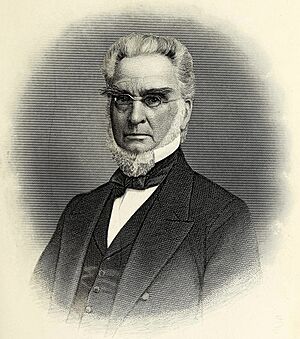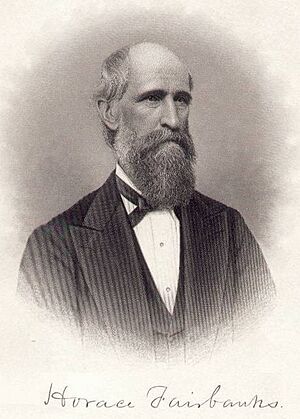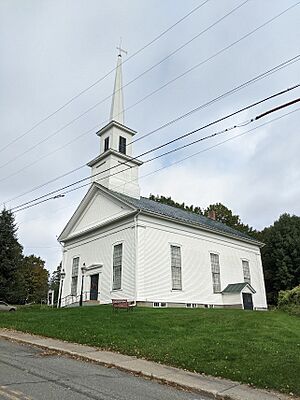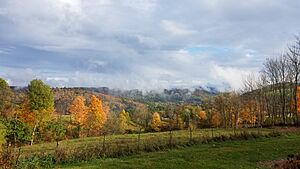Barnet, Vermont facts for kids
Quick facts for kids
Barnet, Vermont
|
|
|---|---|
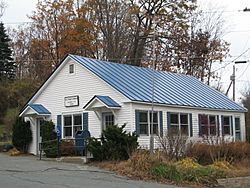
Barnet's post office
|
|
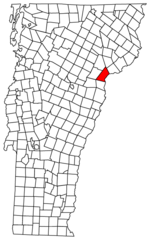
Barnet, Vermont
|
|
| Country | United States |
| State | Vermont |
| County | Caledonia |
| Communities | Barnet Barnet Center East Barnet McIndoe Falls Mosquitoville Passumpsic West Barnet |
| Area | |
| • Total | 43.6 sq mi (112.9 km2) |
| • Land | 42.2 sq mi (109.4 km2) |
| • Water | 1.3 sq mi (3.4 km2) |
| Elevation | 1,083 ft (330 m) |
| Population
(2020)
|
|
| • Total | 1,663 |
| • Density | 39/sq mi (15.2/km2) |
| Time zone | UTC-5 (Eastern (EST)) |
| • Summer (DST) | UTC-4 (EDT) |
| ZIP codes |
05821 (Barnet)
05050 (McIndoe Falls) 05861 (Passumpsic) 05819 (St. Johnsbury) 05042 (East Ryegate) 05046 (Groton) |
| Area code(s) | 802 |
| FIPS code | 50-02875 |
| GNIS feature ID | 1462034 |
Barnet is a town in Caledonia County, Vermont, United States. In 2020, about 1,663 people lived there. The town includes several smaller communities. These are Barnet Center, East Barnet, McIndoe Falls, Mosquitoville, Passumpsic, and West Barnet. The main village, also called Barnet, had 127 residents in 2020.
Contents
History of Barnet, Vermont
The town of Barnet, Vermont, got its name from a town in England. This happened on September 16, 1763. The royal governor of New Hampshire, Benning Wentworth, officially gave the town its charter.
The first European settlers to live and work the land were three brothers: Daniel, Jacob, and Elijah Hall. They came with Jonathan Fowler. Their home was built near the Connecticut River and McIndoe Falls. Elijah Hall built the first house in Caledonia County.
Colonel Alexander Harvey came from Dundee, Scotland. He wanted to help people find new land in the American colonies. Even though he lost touch with most of them after the American Revolution, he decided to stay. He claimed about 7,000 acres (28 km²) of land and a lake. This lake is now known as Harvey's Lake.
Barnet has several early villages and hamlets:
- Barnet village (once called Stevens Village) is by the river falls.
- McIndoe Falls (also McIndoes) is in the southeast, also by falls.
- Passumpsic (formerly Kendall's Mills) is in the northeast. It spreads into the town of Waterford.
- East Barnet (named Norrisville in 1875) is near where the river enters a deep gorge.
- West Barnet is at the end of Harvey Lake, on the road to Peacham.
- Mosquitoville is south of Harvey Lake.
- Barnet Center is on the road from Barnet village to West Barnet.
The main Barnet village has grown. People often call it "the town," but the town itself includes all these places.
Two governors of Vermont came from Barnet. They were Erastus Fairbanks (who served 1852–1853 and 1860–1861) and his son, Horace Fairbanks (who served 1876–1878). The Fairbanks family later moved to St. Johnsbury. There, they became famous for making the first platform scale.
The famous ocean explorer and scuba inventor, Jacques Cousteau, had important experiences in Barnet. As a young boy in the early 1920s, he visited Harvey's Lake. He experimented with breathing underwater using hollow reeds. This helped him stay underwater for a long time, even before he could swim well.
Religious History in Barnet
Christian Faiths
On January 24, 1784, the town of Barnet chose the Presbyterian faith as its official religion. They believed it was based on the "word of God."
The Passumpsic Calvinistic Baptist church started on July 1, 1812. They chose Passumpsic village because it was easy for everyone to reach.
The First Congregational Church of Barnet began in September 1829. This was after a new brick church was built. The church building you see today was built in 1854.
The earliest Reformed Presbyterian Church in Vermont was in Ryegate in 1798. Later, some members in Barnet built a new meeting house. It was on land once owned by Walter Harvey. The longest-serving minister there was Daniel C. Faris, from 1873 to 1923. The Barnet branch became its own church in 1872 and continued until 1970.
Buddhism in Barnet
In 1970, Chögyam Trungpa came to North America. He started a teaching center called "Tail of the Tiger" in Barnet. This center is now known as Karmê Chöling. Later, it joined with other centers in Colorado.
Geography and Climate
Barnet covers about 112.9 square kilometers (43.6 square miles). Most of this is land (109.4 km² or 42.2 sq mi), and a small part is water (3.4 km² or 1.3 sq mi). The main Barnet village area is smaller, about 1.66 km² (0.64 sq mi).
The Connecticut River forms the eastern border of the town. This river also separates Vermont from New Hampshire. The Passumpsic River flows into the Connecticut River at East Barnet.
Barnet is surrounded by other towns. To the south is Ryegate. To the southwest is Groton. Peacham is to the west, and Danville is to the northwest. To the north is St. Johnsbury, and Waterford, Vermont is to the northeast. Across the Connecticut River in New Hampshire is Monroe.
Interstate 91 runs through Barnet from north to south. You can get to the town from Exit 18. U.S. Route 5 is another road that goes through the town center.
The highest point in Barnet is Roy Mountain. It is about 641 meters (2,103 feet) tall. It is in the southern part of town, east of Harvey Lake.
Weather in Barnet
Barnet has a humid continental climate. This means it has big changes in temperature throughout the year. Summers are warm to hot, and winters are very cold.
| Climate data for Barnet, Vermont | |||||||||||||
|---|---|---|---|---|---|---|---|---|---|---|---|---|---|
| Month | Jan | Feb | Mar | Apr | May | Jun | Jul | Aug | Sep | Oct | Nov | Dec | Year |
| Mean daily maximum °C | −3.2 | −2.1 | 3.9 | 10.7 | 18.9 | 24.4 | 27.0 | 25.9 | 21.8 | 15.3 | 6.6 | −1.3 | 12.3 |
| Daily mean °C | −9.9 | −9.2 | −2.5 | 4.6 | 11.8 | 17.4 | 20.2 | 19.1 | 15.0 | 8.7 | 1.7 | −6.7 | 5.8 |
| Mean daily minimum °C | −16.6 | −16.4 | −9.0 | −1.5 | 4.6 | 10.3 | 13.3 | 12.3 | 8.3 | 2.1 | −3.2 | −12.1 | −0.7 |
| Average precipitation mm | 51 | 48 | 5 | 72 | 83 | 84 | 98 | 89 | 83 | 78 | 86 | 62 | 888 |
| Average snowfall cm | 43.9 | 46.5 | 29.5 | 7.4 | 0.2 | — | — | — | — | 0.2 | 13.2 | 37.9 | 179.1 |
| Mean daily maximum °F | 26.2 | 28.2 | 39.0 | 51.3 | 66.0 | 75.9 | 80.6 | 78.6 | 71.2 | 59.5 | 43.9 | 29.7 | 54.1 |
| Daily mean °F | 14.2 | 15.4 | 27.5 | 40.3 | 53.2 | 63.3 | 68.4 | 66.4 | 59.0 | 47.7 | 35.1 | 19.9 | 42.4 |
| Mean daily minimum °F | 2.1 | 2.5 | 15.8 | 29.3 | 40.3 | 50.5 | 55.9 | 54.1 | 46.9 | 35.8 | 26.2 | 10.2 | 30.7 |
| Average precipitation inches | 2.0 | 1.9 | 0.2 | 2.8 | 3.3 | 3.3 | 3.9 | 3.5 | 3.3 | 3.1 | 3.4 | 2.4 | 35.0 |
| Average snowfall inches | 17.3 | 18.3 | 11.6 | 2.9 | 0.1 | — | — | — | — | 0.1 | 5.2 | 14.9 | 70.5 |
| Average precipitation days | 13 | 12 | 12 | 13 | 13 | 13 | 12 | 11 | 11 | 11 | 14 | 13 | 148 |
Population and People
| Historical population | |||
|---|---|---|---|
| Census | Pop. | %± | |
| 1790 | 477 | — | |
| 1800 | 858 | 79.9% | |
| 1810 | 1,301 | 51.6% | |
| 1820 | 1,488 | 14.4% | |
| 1830 | 1,764 | 18.5% | |
| 1840 | 2,030 | 15.1% | |
| 1850 | 2,521 | 24.2% | |
| 1860 | 1,994 | −20.9% | |
| 1870 | 1,945 | −2.5% | |
| 1880 | 1,907 | −2.0% | |
| 1890 | 1,897 | −0.5% | |
| 1900 | 1,763 | −7.1% | |
| 1910 | 1,707 | −3.2% | |
| 1920 | 1,685 | −1.3% | |
| 1930 | 2,604 | 54.5% | |
| 1940 | 1,596 | −38.7% | |
| 1950 | 1,425 | −10.7% | |
| 1960 | 1,445 | 1.4% | |
| 1970 | 1,342 | −7.1% | |
| 1980 | 1,338 | −0.3% | |
| 1990 | 1,415 | 5.8% | |
| 2000 | 1,690 | 19.4% | |
| 2010 | 1,708 | 1.1% | |
| 2020 | 1,663 | −2.6% | |
| U.S. Decennial Census | |||
In 2000, Barnet had 1,690 people living in 638 households. About 440 of these were families. The town had about 15.4 people per square kilometer (39.9 per square mile). Most residents (96.75%) were White.
About 32.4% of households had children under 18. Most households (58.5%) were married couples. About 26% of households were single people. Around 12.5% of homes had someone 65 or older living alone.
The average household had 2.57 people. Families had an average of 3.11 people. The median age in town was 40 years old. About 26.7% of the population was under 18.
Famous People from Barnet
Many interesting people have connections to Barnet:
- George H. Amidon – A state treasurer for Vermont.
- Neko Case – A well-known musician.
- Taylor Coppenrath – A professional basketball player.
- Jacques Cousteau – A famous ocean explorer and inventor of SCUBA gear. He had his first dive at Harvey's Lake.
- Jay Craven – A filmmaker and film professor.
- Ralph Flanders – An engineer, industrialist, and politician.
- Luis Guzman – A popular actor.
- Chris Hedges – An author.
- Henry Clay Ide – A statesman and judge.
- Anne Morrow Lindbergh – An author and aviator. She passed away in Passumpsic in 2001.
- Harvey T. Moore – A state legislator for Vermont and Wisconsin. He was born in Barnet.
- Benjamin Franklin Stevens – A bibliographer (someone who studies books).
- Henry Stevens – Also a bibliographer.
See also
 In Spanish: Barnet (Vermont) para niños
In Spanish: Barnet (Vermont) para niños



